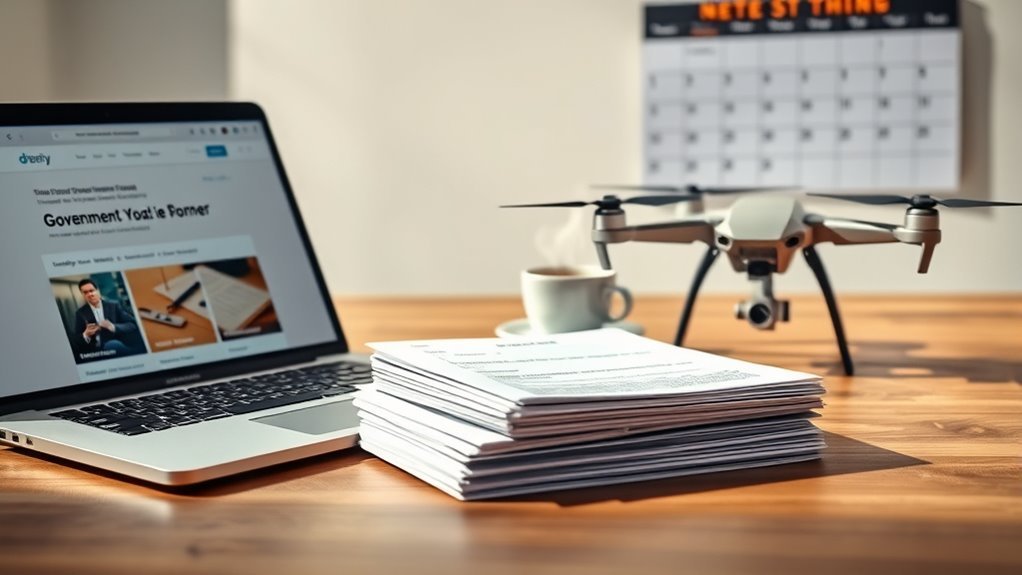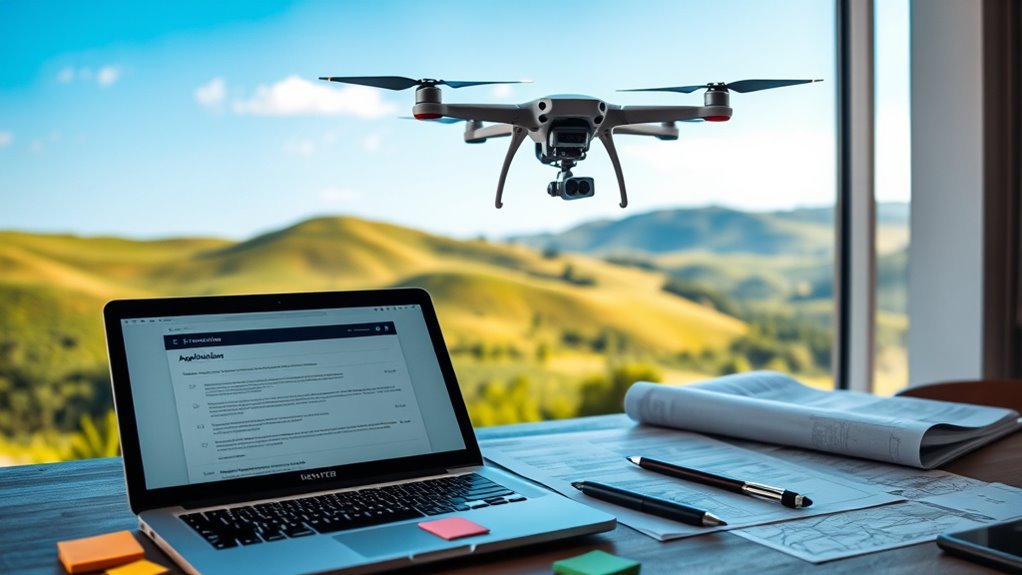To obtain a drone permit, start by familiarizing yourself with local regulations and your drone’s classification based on weight and type. Next, register your drone online, providing necessary documentation. Once registered, gather required documents to apply for a permit, including proof of registration and identification. After securing your permit, guarantee ongoing compliance with regulations, conduct regular inspections, and stay updated on any changes. Continue on to explore detailed steps for a successful application process.
Understanding Drone Regulations

When you’re considering flying a drone, it’s essential to understand the regulations that govern their use. Familiarizing yourself with legal requirements is important for safe and responsible drone usage. Each country has specific rules, often dictated by aviation authorities, including height restrictions, no-fly zones, and registration mandates. You’ll need to make sure your drone complies with these regulations to avoid hefty fines or legal action. Additionally, understanding the privacy laws related to drone operations is critical, especially when capturing images or video. By staying informed about these regulations, you can enjoy the freedom of flying your drone without running into legal troubles. Knowledge is your best ally in traversing the drone landscape effectively. Compliance with restrictions is essential to avoid penalties. Furthermore, securing appropriate permits is crucial to ensure that you are flying legally in designated areas.
Determine Your Drone’s Classification

Before you apply for a drone permit, it’s essential to determine your drone’s classification, as this will affect the regulations you need to follow. Drones are categorized primarily by their types and weight categories. Understanding these distinctions is vital for compliance and operational freedom.
There are three weight categories: under 0.55 pounds (250 grams), between 0.55 pounds and 55 pounds (25 kilograms), and above 55 pounds. Each category has specific rules regarding registration and usage.
Additionally, drone types include multi-rotors, fixed-wing, and hybrid models, each serving different purposes and applications. Identifying your drone’s classification will streamline your path to obtaining the necessary permit and guarantee you’re flying within legal boundaries.
Registering Your Drone

Once you’ve determined your drone’s classification, the next step is registering it with the appropriate authorities. The drone registration process is essential for ensuring compliance and protecting your freedom to fly. You’ll need to gather the necessary documentation, which typically includes proof of identity and aircraft details.
Visit the official registration website for your country, where you’ll fill out an online form. Depending on your drone’s weight and usage, you may be required to pay a small fee. Once submitted, you’ll receive a registration number, which must be displayed on your drone. By completing this step, you’re taking an important action to uphold safety regulations while enjoying the benefits of drone flying.
Applying for a Permit
To guarantee you’re flying your drone legally and safely, you’ll need to apply for a permit if required by your local regulations. Start by completing the permit application, which may vary depending on your location. Gather the required documents, such as proof of registration, identification, and any applicable insurance details. Confirm all information is accurate and up-to-date to avoid delays. Some jurisdictions may also ask for a flight plan or purpose of use, so be prepared to provide that information. Once submitted, monitor the application status and be ready to respond to any requests for clarification from the issuing authority. Securing your permit not only grants you freedom to fly but also assures you’re adhering to legal standards.
Maintaining Compliance and Safety Standards
After securing your drone permit, maintaining compliance and safety standards becomes essential. You’ll need to adhere to established safety protocols to guarantee safe operation. Regular compliance checks should be part of your routine, verifying that you’re following all regulations and guidelines. This includes monitoring airspace restrictions, keeping your drone in sight, and avoiding crowds or restricted areas. Additionally, make sure your drone is in good working condition by conducting pre-flight inspections and addressing any maintenance issues promptly. Staying informed about updates in drone regulations will also help you maintain compliance. By prioritizing these practices, you can enjoy the freedom of flying your drone while minimizing risks and ensuring safety for yourself and others. Furthermore, understanding local drone regulations is crucial in ensuring you remain compliant with the law, as failing to register your drone can lead to significant legal penalties.
Frequently Asked Questions
How Much Does a Drone Permit Cost?
When you’re maneuvering the skies with your drone, the permit fees can vary. Expect to pay anywhere from $5 to several hundred dollars, depending on the application process and your specific needs.
Can I Fly My Drone at Night?
Yes, you can fly your drone at night, but you must follow night flying regulations. Make certain your drone has the required lighting to be visible and to comply with safety standards during nighttime operations.
What if My Drone Is a Gift?
Gifting a drone? Don’t disregard drone registration! As a new owner, it’s essential you register your gift promptly. This guarantees compliance, enhances your freedom to fly, and safeguards your fun-filled aerial adventures. Enjoy your new toy!
How Long Does the Permit Process Take?
Permit processing times can vary, but typically range from a few days to several weeks. For quicker approval, consider application submission tips like ensuring all documents are complete and following guidelines precisely. Patience is essential!
Are There Restrictions for Flying Near Airports?
Yes, there’re strict flight regulations regarding airport proximity. You can’t fly drones within five miles of an airport without prior authorization. Always check local guidelines to guarantee you comply and protect your flying freedom.

